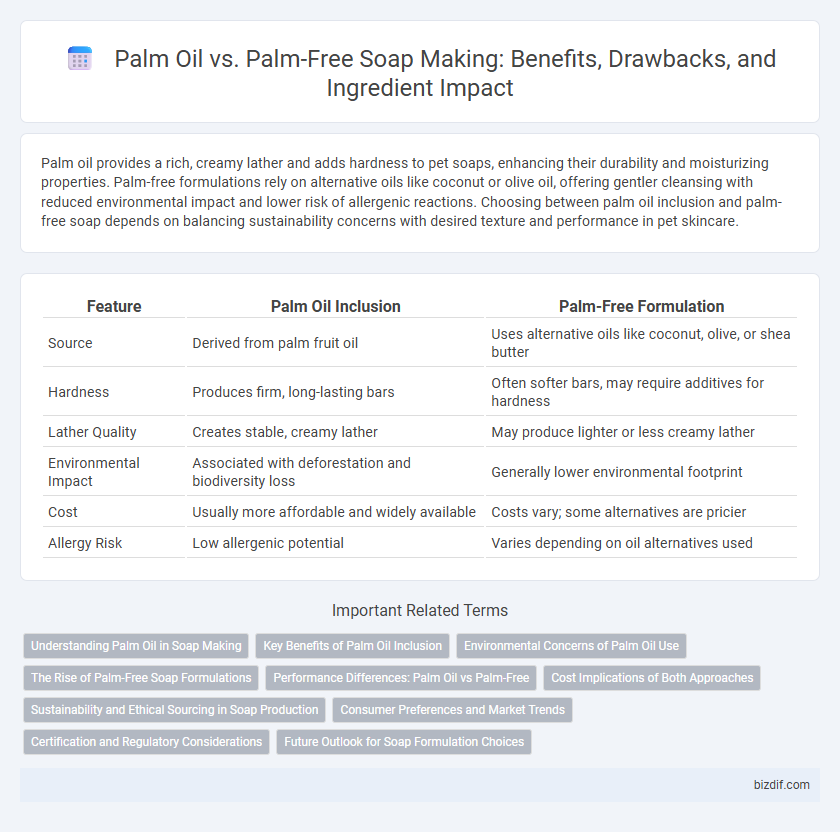Palm oil provides a rich, creamy lather and adds hardness to pet soaps, enhancing their durability and moisturizing properties. Palm-free formulations rely on alternative oils like coconut or olive oil, offering gentler cleansing with reduced environmental impact and lower risk of allergenic reactions. Choosing between palm oil inclusion and palm-free soap depends on balancing sustainability concerns with desired texture and performance in pet skincare.
Table of Comparison
| Feature | Palm Oil Inclusion | Palm-Free Formulation |
|---|---|---|
| Source | Derived from palm fruit oil | Uses alternative oils like coconut, olive, or shea butter |
| Hardness | Produces firm, long-lasting bars | Often softer bars, may require additives for hardness |
| Lather Quality | Creates stable, creamy lather | May produce lighter or less creamy lather |
| Environmental Impact | Associated with deforestation and biodiversity loss | Generally lower environmental footprint |
| Cost | Usually more affordable and widely available | Costs vary; some alternatives are pricier |
| Allergy Risk | Low allergenic potential | Varies depending on oil alternatives used |
Understanding Palm Oil in Soap Making
Palm oil is a popular ingredient in soap making due to its ability to produce a hard bar with a creamy lather, enhancing the soap's durability and cleansing properties. Including palm oil provides a balance of saturated and unsaturated fats, which contributes to the soap's stability and moisturizing qualities. Palm-free formulations often rely on alternative oils like coconut, olive, or shea butter to achieve similar texture and performance while addressing environmental and ethical concerns related to palm oil production.
Key Benefits of Palm Oil Inclusion
Palm oil inclusion in soap making offers superior moisturizing properties and a stable, creamy lather essential for high-quality bar soaps. Rich in natural antioxidants like vitamin E and carotenoids, palm oil enhances the soap's skin-nourishing benefits and extends shelf life. Its balanced fatty acid profile contributes to excellent hardness and longevity, reducing soap degradation over time.
Environmental Concerns of Palm Oil Use
Palm oil inclusion in soap making raises significant environmental concerns due to widespread deforestation, habitat loss, and biodiversity decline associated with palm plantations. Palm-free formulations help reduce the ecological footprint by avoiding these issues and promoting the use of sustainable alternatives such as coconut oil, olive oil, or shea butter. The choice between palm oil and palm-free ingredients directly impacts the sustainability profile and carbon emissions of soap production.
The Rise of Palm-Free Soap Formulations
The rise of palm-free soap formulations reflects growing environmental concerns and consumer demand for sustainable ingredients, leading many soap makers to replace palm oil with alternatives like coconut oil, shea butter, and olive oil. Palm oil, while versatile and cost-effective, is linked to deforestation and habitat loss, driving the industry toward eco-friendly substitutes that maintain soap quality and lather. This shift promotes biodiversity preservation and aligns with ethical sourcing practices increasingly valued by conscious consumers.
Performance Differences: Palm Oil vs Palm-Free
Palm oil in soap formulation enhances hardness, creates a stable lather, and increases moisturizing properties due to its balanced saturated fat content. Palm-free soaps often rely on alternative oils like coconut or olive, which can result in softer bars with a creamier lather but may lack the same degree of longevity and firmness. Performance differences are evident in soap durability and foam stability, with palm oil soaps typically lasting longer and producing a denser, more resilient lather compared to palm-free variants.
Cost Implications of Both Approaches
Palm oil inclusion in soap making generally reduces production costs due to its widespread availability and lower price compared to many alternative oils, making it a cost-effective choice for bulk manufacturing. Palm-free formulations often rely on pricier substitutes like coconut oil, olive oil, or shea butter, which can significantly increase raw material expenses and overall production costs. Cost differences influence product pricing strategies and market positioning, with palm-free soaps appealing to niche markets willing to pay a premium for sustainability and ethical sourcing.
Sustainability and Ethical Sourcing in Soap Production
Palm oil inclusion in soap making offers biodegradability and excellent lathering properties but raises concerns over deforestation and habitat loss linked to unsustainable palm plantations. Opting for palm-free formulations often involves ingredients like coconut oil or shea butter, which may reduce environmental impacts but can affect soap texture and shelf life. Ethical sourcing through certified sustainable palm oil (RSPO) supports responsible agriculture, balancing performance with ecological and social responsibility in soap production.
Consumer Preferences and Market Trends
Palm oil inclusion in soap making remains popular due to its affordability, moisturizing properties, and ability to create a hard bar, appealing to budget-conscious consumers. However, the rising demand for sustainable and eco-friendly products drives the growth of palm-free formulations, attracting environmentally aware buyers seeking cruelty-free and deforestation-free options. Market trends indicate a significant shift towards palm-free soaps as brands prioritize ethical sourcing and transparency to meet evolving consumer preferences.
Certification and Regulatory Considerations
Palm oil inclusion in soap formulations often requires adherence to RSPO (Roundtable on Sustainable Palm Oil) certification standards to ensure sustainable sourcing and compliance with environmental regulations. Palm-free formulations bypass such certification complexities but must still meet strict labeling and ingredient disclosure requirements under FDA or EU cosmetic regulations. Both approaches demand rigorous documentation to maintain transparency and consumer trust in soap product integrity.
Future Outlook for Soap Formulation Choices
The future of soap formulation increasingly favors sustainable and ethically sourced ingredients, with palm-free options gaining traction due to environmental concerns surrounding palm oil production. Advances in biodegradable surfactants and plant-based alternatives offer effective cleansing properties without compromising ecological responsibility. Consumer demand for transparent sourcing and cruelty-free formulations drives innovation toward palm-free soap formulations with reduced carbon footprints.
Palm Oil Inclusion vs Palm-Free Formulation Infographic

 bizdif.com
bizdif.com